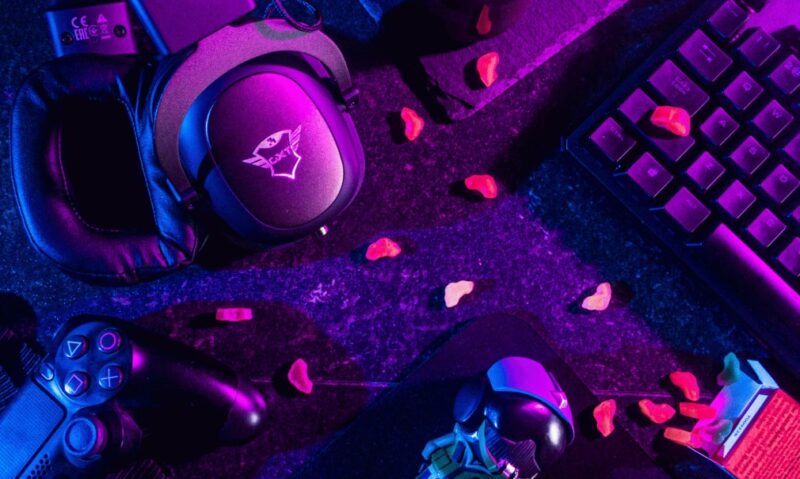The gaming industry is a multi-billion-dollar giant driven by technological innovation. Photorealistic graphics make games look real while other advancements enhance the playing experience.
In this article, we explore current tech trends and innovations that are taking the gaming industry to the next level.
1. Cloud Gaming
Cloud gaming solutions have enabled people to enjoy many of their favorite, high-profile titles without fancy hardware. Services like Xbox Cloud Gaming, NVIDIA GeForce Now and Google Stadia give players the chance to access games on the cloud without the need for physical copies. A recent study revealed that the global cloud gaming market is worth $8.17 billion and is estimated to rise by a CAGR of 68.3% by 2025.
2. Artificial Intelligence (AI)
The integration of AI has significantly elevated the gaming experience, improving everything from NPC behavior to procedural content generation. For example, AI-powered bots in The Last of Us Part II pose more of a strategic challenge, rendering the gameplay highly realistic. AI algorithms will also develop dynamic storylines, giving the experience a personal touch.
3. Virtual Reality (VR) and Augmented Reality (AR)
3D environments or virtual elements merging with the real world through augmented reality (AR) and virtual reality (VR) are increasingly prevalent. Games like Beat Saber (VR) and Pokémon GO (AR) are examples of this latest evolution. The value of the VR gaming market is expected to exceed $12 billion in revenues by 2024.
The iGaming industry has been an early adopter of VR/AR, especially in immersive experiences like live dealer games. Click here to check out how tech innovations are improving games like live dealer baccarat.

4. Mobile Gaming Advancements
Mobile gaming has seen rapid growth, thanks to hardware improvements and better internet connectivity. Smartphones today are equipped with powerful processors and GPUs, enabling games like Call of Duty Mobile to rival traditional console titles in graphics and gameplay. Additionally, innovations such as cloud integration allow players to switch seamlessly between devices without losing progress.
Key benefits of these Innovations:
- Accessibility ─ High-quality games are now playable on budget-friendly devices.
- Cross-platform play ─ Features that let users enjoy games across consoles, PCs, and smartphones.
- Enhanced social features ─ Players can easily connect and collaborate in multiplayer settings.
5. Blockchain and NFTs
Games built on blockchain networks can offer a range of unique features, and are driving a new game economy. Non-Fungible Tokens (NFTs) available through these blockchain games give players ownership of in-game assets which they can sell and trade on dedicated marketplaces.
6. Haptic Feedback and Wearables
Improvements in haptic technology enable players to get those tactile experiences. The PlayStation DualSense controller or haptic vests from Teslasuit simulate physical experiences such as feeling the rattle of a car or raindrops on the skin in a game.
7. Game Streaming and Content Creation Tools
Nowadays, millions of people enjoy watching video game streamers and competitions using platforms like Twitch and YouTube Gaming. Streaming technology means anyone can stream games, from casual fans to celebrities and influencers. This has transformed the gaming world and helped push it further into the mainstream.

8. Procedural Generation
RPGs that feature procedural generation include titles like Minecraft and No Man’s Sky, which contain seemingly infinite possibilities in their unique worlds. This feature saves development time and makes for a more interesting, engaging player experience. They offer something different on every playthrough, improving player retention rates.
9. Improved Graphics Engines
Emerging graphics engines like Unreal Engine 5 produce photorealistic images, thanks to features like dynamic lighting, which offer a new benchmark in game design. With improved environmental and character design, players can enjoy truly immersive experiences with stunning visuals.
Accessibility Innovations in Gaming
Inclusivity has become a central focus in game development. Features like customizable controls, subtitles, and color-blind modes help a wider audience participate. Notable strides include the Xbox Adaptive Controller, designed to provide access for gamers with physical disabilities.
Core enhancements to accessibility:
- Voice Commands for hands-free controls.
- Customizable difficulty settings that cater to varied skill levels.
- Better hardware options for people with mobility challenges.
The Rise of Esports
Competitive gaming has exploded, becoming a global phenomenon. Esports tournaments now attract millions of viewers and offer prize pools worth millions of dollars. Games like League of Legends and Fortnite have taken center stage, blending entertainment with skill-based challenges. Sponsorships, streaming revenue, and professional teams have elevated esports into a lucrative ecosystem.

Environmental Impact of Gaming Technology
Gaming hardware and data centers consume significant energy, leading to sustainability concerns. Companies now work towards creating energy-efficient systems. Innovations include eco-friendly gaming consoles and reduced server energy consumption, all part of efforts to decrease the industry’s environmental footprint.
Steps toward sustainability:
- Use of recyclable materials in hardware production.
- Energy-efficient GPUs and processors.
- Cloud-based systems reducing reliance on physical game copies.
Enhanced Multiplayer Experiences:
Advances in matchmaking algorithms and communication tools have greatly improved multiplayer environments. Real-time voice chat, team coordination apps, and fair matchmaking systems ensure a smoother gaming experience. Developers increasingly use analytics to prevent toxic behavior, fostering a positive atmosphere for players.
Multiplayer games now incorporate shared story arcs, where decisions made by one player affect the narrative for all participants. This trend allows for deeper engagement and creates memorable moments unique to each group of players. Titles like “It Takes Two” exemplify this, emphasizing collaboration in both gameplay and storytelling.
Final Thoughts
Undeniably these innovations have taken gaming to another level, driving engagement, immersion and even the game economy. Gaming continues to coincide with these new trends, promising a future not just of gaming but of an immersive and interactive experience. As technology evolves, the possibilities for storytelling, competition, and connectivity appear endless. Each innovation reaffirms the potential of games as a dominant form of entertainment and a medium for creative expression.
Related Posts:
- The Role of Sweepstakes Casinos in the Gaming Industry
- How Does Edge Computing Reduce Latency For End…
- How to Transition Into Auckland's Tech Industry: A…
- How Modern Cutlery Has Evolved in Kitchen Tools…
- Artificial Intelligence ─ A New Frontier in Gaming
- Turn Your Gaming Hobby into Income - How to Get Started?








